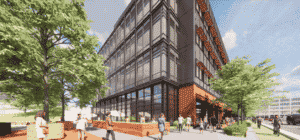
A draft zoning study recommends taller building heights in Somerville’s Brickbottom to accommodate office, labs and housing, with highest densities closest to the MBTA Green Line Extension. Image courtesy of Principle Group and the city of Somerville
Removal of Boston’s elevated Central Artery opened up new connections between the Financial District and waterfront, raising property values and development demand.
Developers and Somerville officials expect the dismantling of the elevated McGrath Highway to have a similar effect upon Brickbottom and Inner Belt, a pair of industrial districts cut off from the rest of the city by this steel barrier. Totaling 150 acres, the industrial neighborhoods are the focus of a city planning study that could result in rezoning to accommodate office, lab and multifamily development.
“In a few decades, this could be downtown Somerville,” said Russell Preston, founder of Boston-based land-use and planning consultants Principle Group.
The first life science project already is under way in Brickbottom, in what could be a harbinger of the neighborhood’s future development potential. Developer North River Leerink recently demolished a warehouse to begin site work and foundations on a 208,600-square-foot speculative lab building that’s scheduled for completion in mid-2023. The firm received $192.5 million in construction financing from New York-based Square Mile Capital on June 3, and is represented by Newmark as leasing agent.
A partnership of North River Leerink and Wheelock Street Capital and made its first acquisition in the neighborhood in 2013, long before East Somerville entered the conversation as a life science cluster. It bought a 200,000-square-foot flex building at 150-200 Inner Belt Road, which is located on eight acres with additional development potential.
North River Leerink added to its Somerville portfolio in recent years with three acquisitions next to the MBTA’s Green Line Extension tracks, including 100 Chestnut and the 86 Joy St. property, which contains 52 artist studios. The parcels have potential to be redeveloped with up to three new buildings, North River Partner Chris Pachios said.
“One unique ability we have is to stitch the neighborhood together between Inner Belt and Brickbottom,” Pachios said of the firm’s holdings in both neighborhoods.
City planners and consultants say North River Leerink will play a key role in maximizing the connections, by designing future projects to accommodate infrastructure such as a potential pedestrian bridge spanning the MBTA tracks.
Rapid Transit Options Set to Multiply

A New York developer received $192.5 million in construction financing this month for a speculative life science project at 100 Chestnut St. in Somerville’s Brickbottom neighborhood. Image courtesy of Gensler
Changes in zoning, planned public transit upgrades and the McGrath Highway’s replacement with an at-grade boulevard could have a transformative effect on the neighborhood in the coming years.
The new East Somerville station on the MBTA’s Green Line Extension is projected to open in late summer near the main entrance into Brickbottom on Washington Street.
T officials are studying several options for an extension of the Silver Line rapid busway, including one route that would travel from Sullivan Square, along Washington Street and a new McGrath Boulevard, before terminating in Kendall Square.
MassDOT is in the 25 percent design phase for the Grounding McGrath Highway project which could begin as soon as 2027, eliminating the six-lane overpass that separates Brickbottom from Union Square and its booming development activity.
And the Somerville Community Path which runs alongside the district is being extended to East Cambridge.
The service upgrades account for the aggressive transportation goals in the new Brickbottom Small Area Plan, which seeks that 75 percent of new trips into the area take place by transit, walking, biking or rideshare services.
The first life science project already is under way in Brickbottom, in what could be a harbinger of the neighborhood’s future development potential.
Tracy Corley, director of research and partnerships at Conservation Law Foundation, said the transit upgrades alone won’t necessarily induce people to abandon their cars. The ratio of housing to commercial space in Brickbottom will play a key role in vehicle usage, Corley said.
“One of the key challenges is a lot of people don’t work in their local communities,” Corley said.
Artist Component Could Be Negotiation Point
Preserving and expanding the neighborhood’s arts community, potentially through zoning requirements in new developments, would benefit commercial developers seeking to differentiate their projects, Principle Group’s Preston said.
“If they want decent commercial growth to occur, it’s people who are going to come here and say, ‘This is going to be cooler than the Seaport or Kendall Square.’ What’s unique about Brickbottom is the artist community that is working and living in this neighborhood,” he said.

Steve Adams
The rezoning study offers an opportunity for the city to negotiate with developers on the arts and cultural space requirements, said Victor Nascimento, senior planner for the city of Somerville. Typically, new developments in Somerville are required to include 5 or 10 percent for arts and creative uses, but Brickbottom could include different standards.
“It may not be as profitable for [developers] as other uses, but [rezoning] would leave them more room for other uses. It will require negotiations and figuring out how to get them on board,” Nascimento said.
The city has had preliminary discussions with North River executives about retaining the Joy Street studios if 86 Joy St. is redeveloped, he said.
In an emailed statement, North River Leerink said it views the artists as “significant stakeholders in the Brickbottom neighborhood, and essential to the fabric of its vibrant community” and is discussing how to bolster the arts and creative presence in the neighborhood with the Somerville Arts Council and affected parties.
Now that the draft planning study has been released, the city will begin a comment period followed by a Planning Board vote on the final plan, Nascimento said. The zoning changes require City Council approval.
Editor’s note: This report has been updated to correct the name of the entity that acquired the development parcels in Brickbottom and Inner Belt.





